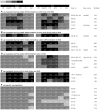Gene expression changes during caste-specific neuronal development in the damp-wood termite Hodotermopsis sjostedti
- PMID: 20482890
- PMCID: PMC2887416
- DOI: 10.1186/1471-2164-11-314
Gene expression changes during caste-specific neuronal development in the damp-wood termite Hodotermopsis sjostedti
Abstract
Background: One of the key characters of social insects is the division of labor, in which different tasks are allocated to various castes. In termites, one of the representative groups of social insects, morphological differences as well as behavioral differences can be recognized among castes. However, very little is known about the neuronal and molecular bases of caste differentiation and caste-specific behavior. In almost all termite species, soldiers play defensive roles in their colonies, and their morphology and behavior are largely different from workers (or pseudergates). Therefore, we predicted that some genes linked to defensive behavior and/or those required for neuronal changes are differentially expressed between workers and soldiers, or during the soldier differentiation, respectively.
Results: Using the brain and suboesophageal ganglion (SOG) of the damp-wood termite Hodotermopsis sjostedti, we first screened genes specifically expressed in soldiers or during soldier differentiation by the differential display method, followed by quantitative real-time polymerase chain reaction. No distinctive differences in expression patterns were detected between pseudergates and soldiers. In the course of soldier differentiation, however, five genes were found to be up-regulated in brain and/or SOG: 14-3-3 epsilon, fibrillin2, beta-tubulin, ciboulot, and a hypothetical protein containing a SAP motif. Some of these genes are thought to be associated with cytoskeletal structure or motor-associated proteins in neuronal tissues.
Conclusion: The identified five genes could be involved in soldier-specific neuronal modifications, resulting in defensive behaviors in termite soldiers. The temporal expression patterns of these genes were consistent with the neuronal changes during soldier differentiation, suggesting that molecular machineries, in which the identified factors would participate, play important roles in behavioral differentiation of termite soldiers.
Figures




Similar articles
-
Tyraminergic and Octopaminergic Modulation of Defensive Behavior in Termite Soldier.PLoS One. 2016 May 19;11(5):e0154230. doi: 10.1371/journal.pone.0154230. eCollection 2016. PLoS One. 2016. PMID: 27196303 Free PMC article.
-
Soldier-specific modification of the mandibular motor neurons in termites.PLoS One. 2008 Jul 9;3(7):e2617. doi: 10.1371/journal.pone.0002617. PLoS One. 2008. PMID: 18612458 Free PMC article.
-
Differential gene expression in response to juvenile hormone analog treatment in the damp-wood termite Hodotermopsis sjostedti (Isoptera, Archotermopsidae).J Insect Physiol. 2013 Apr;59(4):509-18. doi: 10.1016/j.jinsphys.2013.02.002. Epub 2013 Feb 26. J Insect Physiol. 2013. PMID: 23481672
-
The making of the defensive caste: Physiology, development, and evolution of the soldier differentiation in termites.Evol Dev. 2020 Nov;22(6):425-437. doi: 10.1111/ede.12335. Epub 2020 Apr 14. Evol Dev. 2020. PMID: 32291940 Review.
-
Developmental regulation of caste-specific characters in social-insect polyphenism.Evol Dev. 2005 Mar-Apr;7(2):122-9. doi: 10.1111/j.1525-142X.2005.05014.x. Evol Dev. 2005. PMID: 15733310 Review.
Cited by
-
Myosin Gene Expression and Protein Abundance in Different Castes of the Formosan Subterranean Termite (Coptotermes formosanus).Insects. 2012 Nov 16;3(4):1190-9. doi: 10.3390/insects3041190. Insects. 2012. PMID: 26466734 Free PMC article.
-
The homolog of Ciboulot in the termite (Hodotermopsis sjostedti): a multimeric beta-thymosin involved in soldier-specific morphogenesis.BMC Dev Biol. 2010 Jun 8;10:63. doi: 10.1186/1471-213X-10-63. BMC Dev Biol. 2010. PMID: 20529303 Free PMC article.
-
Omic research in termites: an overview and a roadmap.Front Genet. 2015 Mar 13;6:76. doi: 10.3389/fgene.2015.00076. eCollection 2015. Front Genet. 2015. PMID: 25821456 Free PMC article. Review.
-
Recent Advances in Behavioral (Epi)Genetics in Eusocial Insects.Annu Rev Genet. 2018 Nov 23;52:489-510. doi: 10.1146/annurev-genet-120116-024456. Epub 2018 Sep 12. Annu Rev Genet. 2018. PMID: 30208294 Free PMC article. Review.
-
Tyraminergic and Octopaminergic Modulation of Defensive Behavior in Termite Soldier.PLoS One. 2016 May 19;11(5):e0154230. doi: 10.1371/journal.pone.0154230. eCollection 2016. PLoS One. 2016. PMID: 27196303 Free PMC article.
References
-
- Wilson EO. The Insect Societies. Cambridge, MA: The Belknap Press of Harvard University Press; 1971.
Publication types
MeSH terms
LinkOut - more resources
Full Text Sources
Miscellaneous

